Color temperature plays a crucial role in shaping our perception of light and color, influencing both mood and visual clarity. By adjusting the warmth or coolness of light, we can create environments that enhance comfort, focus, and productivity, tailored to specific activities or aesthetic preferences. Understanding these effects allows for more intentional design choices in spaces ranging from homes to workplaces.
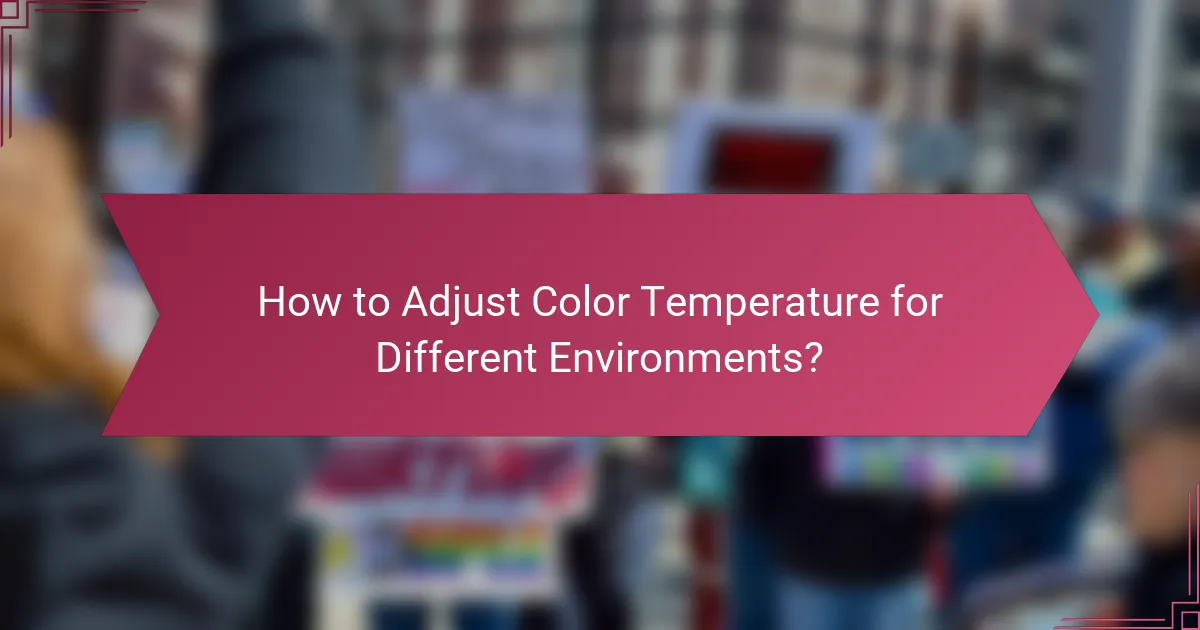
How to Adjust Color Temperature for Different Environments?
Adjusting color temperature involves modifying the warmth or coolness of light in a space to suit specific activities or aesthetics. Different environments require distinct approaches to achieve the desired effect on mood, clarity, and visual comfort.
Adjusting for Photography
In photography, color temperature is crucial for capturing accurate colors. Use a color temperature meter or your camera’s settings to adjust for different lighting conditions, typically ranging from 2500K (tungsten) to 6500K (daylight). Consider using a gray card for white balance adjustments to ensure true-to-life colors.
When shooting indoors with incandescent bulbs, set your camera to a lower Kelvin value to avoid overly warm images. Conversely, for outdoor shots in daylight, a higher Kelvin setting will enhance the cool tones of the scene.
Adjusting for Interior Design
In interior design, color temperature affects the ambiance of a room. Warm light (around 2700K to 3000K) creates a cozy atmosphere, ideal for living spaces, while cooler light (4000K to 5000K) is better suited for work areas, promoting focus and productivity.
Consider layering different light sources with varying color temperatures to create depth and interest. For instance, combine warm ambient lighting with cooler task lighting in a home office to balance comfort and functionality.
Adjusting for Video Production
Video production requires precise color temperature adjustments to maintain consistency across shots. Standard practice is to use daylight-balanced lights (around 5600K) for outdoor scenes and tungsten lights (3200K) for indoor settings. This ensures a cohesive look throughout the footage.
Utilize color correction gels on lights to match the color temperature of your environment. Always check your camera settings to align with the lighting used, as mismatched temperatures can lead to unnatural skin tones and color casts in the final edit.
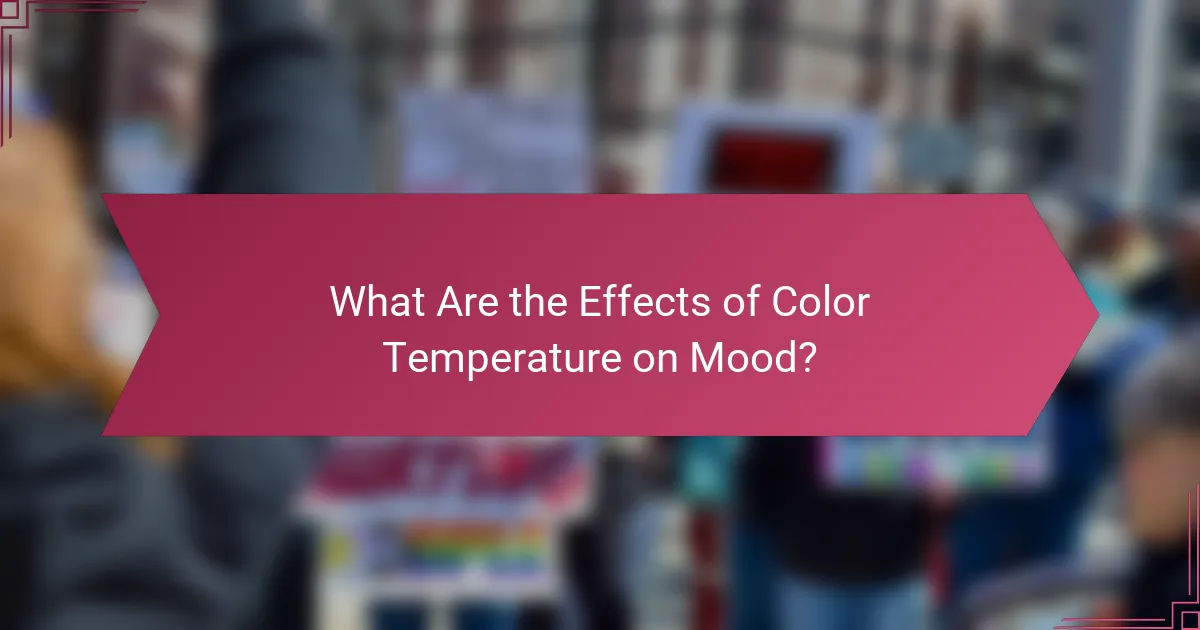
What Are the Effects of Color Temperature on Mood?
Color temperature significantly influences mood by affecting how we perceive our environment. Warmer tones tend to create feelings of comfort and relaxation, while cooler tones can enhance focus and productivity.
Warm Colors and Comfort
Warm colors, such as reds, oranges, and yellows, evoke feelings of warmth and coziness. These hues are often associated with inviting spaces, making them ideal for living rooms or areas designed for relaxation.
To create a comforting atmosphere, consider using warm lighting with a color temperature around 2700K to 3000K. This range mimics the soft glow of candlelight or sunset, promoting a sense of security and calm.
Cool Colors and Productivity
Cool colors, including blues, greens, and purples, are known to enhance concentration and productivity. These shades can create a serene environment that helps reduce stress and encourages focus, making them suitable for workspaces or study areas.
For optimal productivity, aim for lighting with a color temperature between 4000K and 5000K. This cooler light resembles daylight, which can help maintain alertness and energy levels throughout the day.
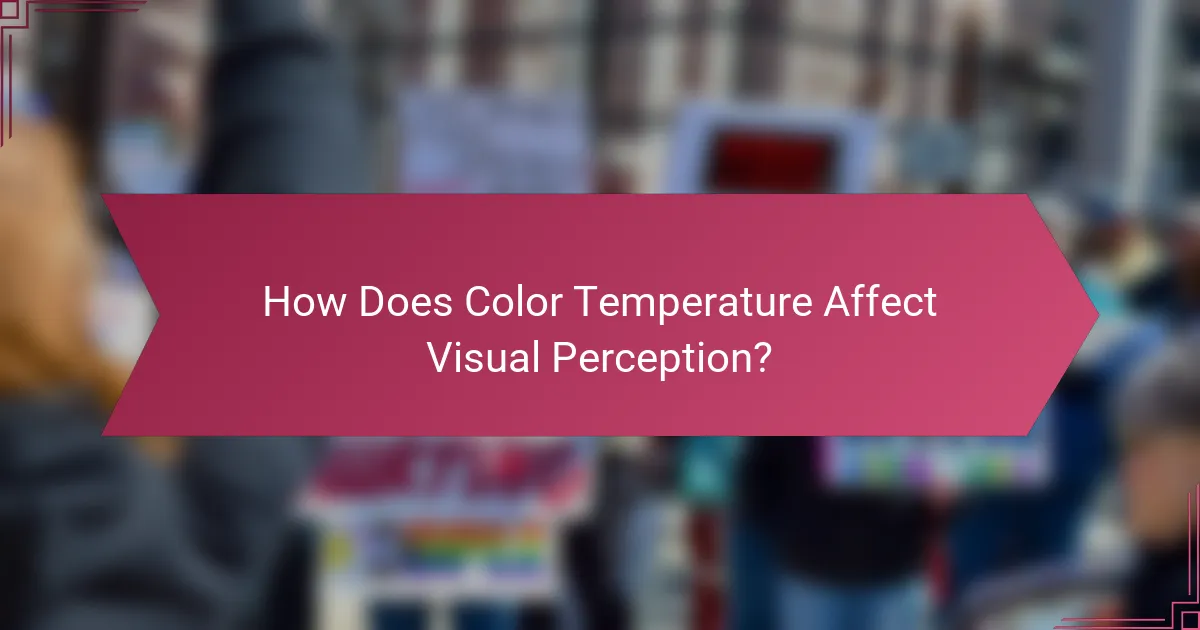
How Does Color Temperature Affect Visual Perception?
Color temperature significantly influences how we perceive colors and visual details. It affects our emotional response and can alter the clarity of images, impacting everything from photography to interior design.
Impact on Color Accuracy
Color accuracy refers to how closely the colors we see match the true colors of objects. Different color temperatures can distort this perception; for instance, warmer light (around 2700K) may enhance reds and yellows, while cooler light (above 5000K) can make blues and greens appear more vibrant. This is crucial in fields like graphic design and photography, where precise color representation is essential.
To achieve accurate color reproduction, it’s advisable to use lighting that matches the intended color temperature of the environment. For example, daylight-balanced lighting (around 5000K to 6500K) is often preferred for tasks requiring high color fidelity, such as painting or product photography.
Influence on Depth Perception
Depth perception is how we perceive the distance between objects, and it can be affected by color temperature. Warmer colors tend to recede, while cooler colors appear to advance, influencing how we interpret spatial relationships in a scene. This is particularly relevant in interior design, where the choice of lighting can create a sense of space or intimacy.
To enhance depth perception, consider using a mix of color temperatures in a space. For instance, combining warm lights for ambient lighting with cooler lights for task areas can create a balanced environment that feels both spacious and inviting. Avoid using overly harsh lighting, as it can flatten depth cues and make spaces feel less dynamic.
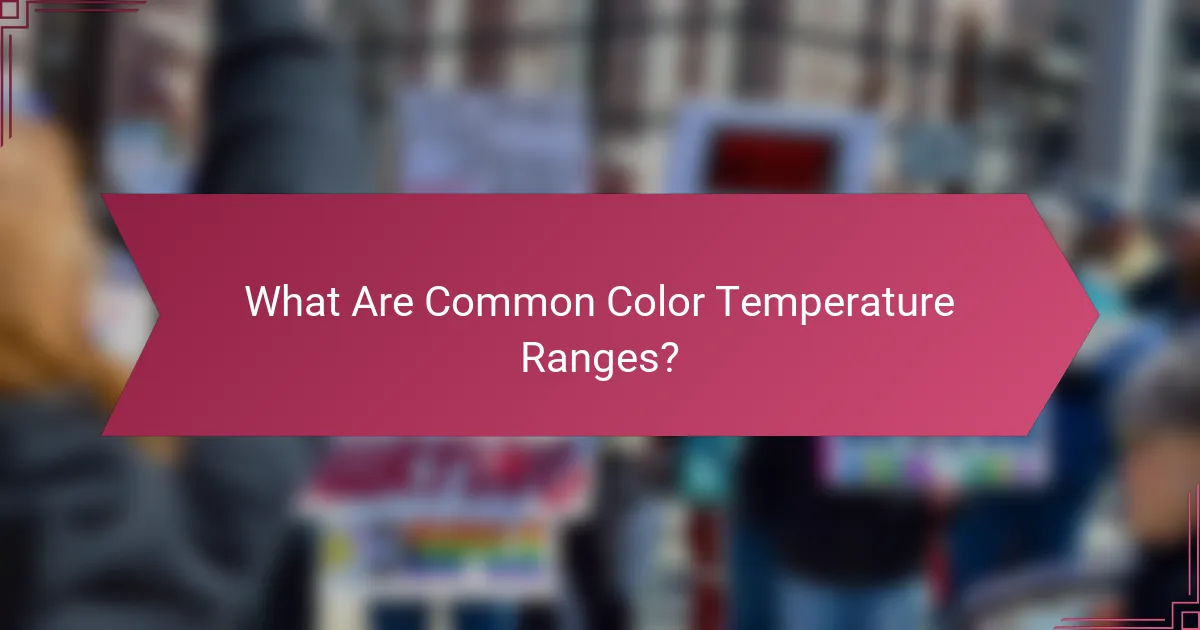
What Are Common Color Temperature Ranges?
Common color temperature ranges are measured in Kelvin (K) and indicate the hue of light emitted by a source. These ranges influence the ambiance and functionality of spaces, with warmer tones creating a cozy atmosphere and cooler tones promoting alertness and focus.
Incandescent Bulbs (2700K-3000K)
Incandescent bulbs typically emit light in the 2700K to 3000K range, producing a warm, yellowish glow. This color temperature is ideal for creating inviting environments, such as living rooms and bedrooms, where relaxation is key.
When using incandescent lighting, consider its lower energy efficiency compared to other options like LED. While they provide a pleasant ambiance, they consume more electricity and have a shorter lifespan, making them less economical in the long run.
Daylight (5000K-6500K)
Daylight bulbs fall within the 5000K to 6500K range, mimicking natural daylight with a bright, bluish tone. This color temperature is suitable for workspaces, kitchens, and areas where clarity and focus are essential.
Choosing daylight bulbs can enhance visibility and reduce eye strain, especially in environments requiring attention to detail. However, be cautious of overusing this cooler light in spaces meant for relaxation, as it may create a less comfortable atmosphere.
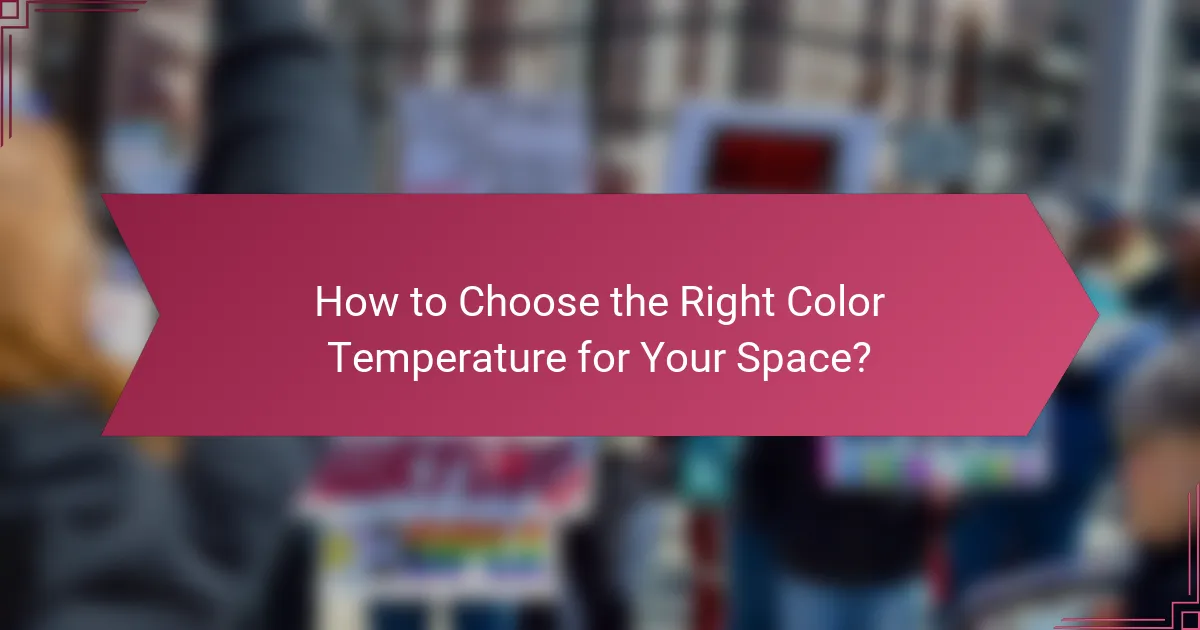
How to Choose the Right Color Temperature for Your Space?
Choosing the right color temperature for your space involves understanding how different temperatures affect mood and functionality. Typically measured in Kelvin (K), color temperatures range from warm (around 2700K) to cool (above 5000K), influencing the ambiance and usability of a room.
Consideration of Room Function
The function of a room significantly impacts the ideal color temperature. For example, warm light (2700K-3000K) is often best for living rooms and bedrooms, creating a cozy atmosphere. In contrast, cooler light (4000K-5000K) is more suitable for workspaces and kitchens, promoting alertness and focus.
When selecting lighting, consider the activities that will take place in the room. A reading nook may benefit from a warmer hue, while a home office might require a brighter, cooler light to enhance productivity.
Influence of Natural Light
Natural light varies throughout the day and can affect how artificial light appears in your space. Rooms with ample natural light may benefit from cooler color temperatures to balance the warm tones of sunlight, especially in the morning and afternoon.
In contrast, spaces that receive limited natural light can feel more inviting with warmer artificial lighting. Observing how your space interacts with sunlight at different times can help you make informed choices about your lighting setup.

What Tools Can Help Measure Color Temperature?
To measure color temperature accurately, you can use specialized tools such as color temperature meters or smartphone applications designed for this purpose. These tools help you determine the warmth or coolness of light sources, which is essential for photography, design, and lighting applications.
Color Temperature Meters
Color temperature meters are dedicated devices that provide precise measurements of light sources in Kelvin (K). They typically feature a sensor that captures light and displays the color temperature reading on a digital screen. These meters are particularly useful for professionals in photography and cinematography, where accurate color representation is crucial.
When selecting a color temperature meter, consider factors such as measurement range, accuracy, and portability. Many models can measure from around 1,000 K (very warm light) to over 10,000 K (cool daylight), allowing for a wide variety of applications. Ensure the device you choose meets your specific needs, whether for studio work or outdoor settings.
Smartphone Apps
Smartphone applications for measuring color temperature offer a convenient alternative to dedicated meters. Many of these apps utilize the phone’s camera and built-in sensors to estimate the color temperature of a light source. While they may not be as precise as dedicated devices, they can still provide useful approximations for casual users.
When using a smartphone app, ensure good lighting conditions for the best results. Some popular apps allow for easy comparisons between different light sources and can even suggest adjustments for achieving desired effects. However, be aware that the accuracy can vary based on the phone model and camera quality, so use them as a guideline rather than a definitive measurement.

How to Create a Color Temperature Adjustment Plan?
Creating a color temperature adjustment plan involves assessing your current lighting and defining the desired atmosphere for your space. This plan helps in achieving the right balance of warmth or coolness in lighting, enhancing both functionality and mood.
Step 1: Assess Current Lighting
Begin by evaluating the existing lighting conditions in your environment. Take note of the color temperature of your current bulbs, which can range from warm (around 2700K) to cool (up to 6500K). Use a color temperature meter or a smartphone app to measure the light quality accurately.
Consider the natural light available throughout the day, as it can significantly influence your indoor lighting needs. For instance, rooms with abundant natural light may require cooler artificial lighting to maintain balance, while darker spaces might benefit from warmer tones.
Step 2: Define Desired Atmosphere
Identify the mood or atmosphere you want to create in each room. For example, warm light (around 2700K to 3000K) is ideal for cozy settings like living rooms and bedrooms, while cooler light (4000K to 5000K) is preferable for workspaces and kitchens to enhance focus and productivity.
Once you have a clear idea of the desired atmosphere, consider how different color temperatures can affect emotions and activities. Create a simple chart to compare the effects of various temperatures on mood, such as relaxation with warm light versus alertness with cool light, to guide your choices effectively.

What Are the Future Trends in Color Temperature Technology?
Future trends in color temperature technology focus on enhancing user experience through improved adaptability and energy efficiency. Innovations are likely to include smart lighting systems that automatically adjust color temperature based on the time of day or user preferences.
Smart Lighting Systems
Smart lighting systems utilize sensors and algorithms to adjust color temperature dynamically. These systems can mimic natural light patterns, promoting well-being and productivity. For instance, warmer tones may be used in the evening to signal relaxation, while cooler tones can enhance alertness during the day.
Human-Centric Lighting
Human-centric lighting emphasizes the impact of light on human health and behavior. This approach considers factors such as circadian rhythms and mood enhancement. Implementing human-centric lighting in workplaces and homes can lead to improved focus and reduced fatigue.
Energy Efficiency Improvements
Advancements in LED technology are driving energy efficiency in color temperature applications. Modern LEDs can produce a wide range of color temperatures while consuming less power compared to traditional bulbs. This shift not only lowers energy costs but also reduces environmental impact.
Integration with Smart Home Systems
As smart home technology evolves, color temperature control will increasingly integrate with home automation systems. Users will be able to set schedules or control lighting remotely via smartphones. This integration enhances convenience and allows for personalized lighting environments.
Regulatory Standards and Guidelines
Future trends may also be shaped by regulatory standards aimed at promoting energy efficiency and health benefits. Organizations like the International Energy Agency (IEA) are likely to influence guidelines that encourage the adoption of advanced color temperature technologies in residential and commercial settings.
